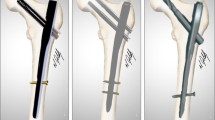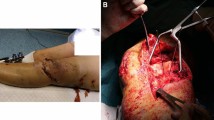Abstract
Purpose
To underline the feasibility of achieving early weight bearing in patients with distal end-segment femur fractures (AO/OTA 33) treated with retrograde intramedullary nailing and supplemental plate or lag screws in the absence of C-arm.
Methods
41 distal end-segment femur fractures (DFFs) included in the study were treated with SIGN nails with or without a side plate in a center that lacked intraoperative fluoroscopy and fracture table. A medial or lateral para-patellar incision was used for fracture reduction, nail insertion and side plate placement. Follow-ups were done at six weeks, 12 weeks, and six months post-operatively.
Results
Distal end-segment fractures constituted 13.2% of all femur fractures treated. The patients’ mean age and range were 49.6 and 23–83 years respectively. They were mostly injured in road traffic accidents. 27 were daily-income earners. By the 12th week post-operatively, 82.1% of them could flex their knee beyond 90°, all of them could bear weight fully, and 71.8% could squat & smile.
Conclusion
The study highlighted the procedure for retrograde nailing of DFFs in a setting without the requisite facilities for minimally-invasive surgeries. The findings demonstrated the feasibility of achieving an expedited weight bearing for the predominantly daily-income-earning victims to ensure early return to work and poverty reduction. While the small sample size is a limitation, the study does provide information that could serve as a basis for future randomized controlled trials in low-resource settings.





Similar content being viewed by others
Data availability
The datasets used and/or analyzed during the current study are available from the corresponding author upon reasonable request.
References
Gwathmey FW Jr, Jones-Quaidoo SM, Kahler D, Hurwitz S, Cui Q (2010) Distal femoral fractures: current concepts. J Am Acad Orthop Surg 18(10):597–607. https://doi.org/10.5435/00124635-201010000-00003
Meinberg EG, Agel JMA, Roberts CS, Karam MD, Kellam JF (2018) Fracture and dislocation classification compendium - 2018. J Orthop Trauma 32(Suppl 1):S1-170. https://doi.org/10.1097/BOT.0000000000001063
Garala K, Ramoutar D, Li J, Syed F, Arastu M, Ward J, Patil S (2022) Distal femoral fractures: a comparison between single lateral plate fixation and a combined femoral nail and plate fixation. Injury 53(2):634–639. https://doi.org/10.1016/j.injury.2021.11.011
von Keudell A, Shoji K, Nasr M, Lucas R, Dolan R, Weaver MJ (2016) Treatment options for distal femur fractures. J Orthop Trauma 30(Suppl 2):S25–S27. https://doi.org/10.1097/BOT.0000000000000621
Krettek C, Miclau T, Stephan C, Tscheme H (1999) Transarticular approach and retrograde plate osteosynthesis (TARPO): an alternative surgical approach for complex distal intra-articular femur fractures. Techn Orthop 14(3):219–229. https://doi.org/10.1097/00013611-199909000-00008
Toogood P, Huang A, Siebuhr K, Miclau T (2018) Minimally invasive plate osteosynthesis versus conventional open insertion techniques for osteosynthesis. Injury 49(Suppl 1):S19–S23. https://doi.org/10.1016/S0020-1383(18)30297-3
Canadian orthopedic Trauma Society (2016) Are locking constructs in distal femoral fractures always best? a prospective multicenter randomized controlled trial comparing the less invasive stabilization system with the minimally invasive dynamic condylar screw system. J Orthop Trauma 30(1):e1-6. https://doi.org/10.1097/BOT.0000000000000450
Hoskins W, Sheehy R, Edwards ER, Hau RC, Bucknill A, Parsons N, Griffin XL (2016) Nails or plates for fracture of the distal femur? data from the victoria orthopedic trauma outcomes registry. Bone Joint J 98(6):846–850. https://doi.org/10.1302/0301-620X.98B6.36826
Aggarwal S, Rajnish RK, Kumar P, Srivastava A, Rathor Haq KRU (2022) Comparison of outcomes of retrograde intramedullary nailing versus locking plate fixation in distal femur fractures: a systematic review and meta-analysis of 936 patients in 16 studies. J Orthop 15(36):36–48. https://doi.org/10.1016/j.jor.2022.12.007
Said A (2019) Retrograde nailing versus locked plating for distal femur fractures. The Egyptian Orthop J 54(4):287–296. https://doi.org/10.4103/eoj.eoj_1_21
Galante C, Djemetio MDT, Fratus A, Cattaneo S, Ronchi S, Domenicucci M, Milano G, Casiraghi A (2023) Management of distal femoral fractures with metaphyseal and articular comminution (AO/OTA 33C) using nail and plate fixation: a technical note and case series of 14 patients. Eur J Orthop Surg Traumatol. https://doi.org/10.1007/s00590-023-03577-z
Stoffel K, Sommer C, Lee M, Zhu TY, Schwieger K, Finkemeier C (2022) Double fixation for complex distal femoral fractures. EFORT Open Rev 7(4):274–286. https://doi.org/10.1530/EOR-21-0113
Kontakis MG, Giannoudis PV (2023) Nail plate combination in fractures of the distal femur in the elderly: a new paradigm for optimum fixation and early mobilization? Injury 54(2):288–291. https://doi.org/10.1016/j.injury.2022.11.035
Agunda M, Gakuu LN, Museve GK (2013) Early functional outcome of distal femoral fractures at Kenyatta National Hospital and Kikuyu Hospital. East Afr Orthop J 7(1):57–63
Lemsanni M, Najeb Y (2021) Outcomes of distal femoral fractures treated with dynamic condylar screw (DCS) plate system: a single center experience spanning 15 years. Pan Afr Med J 38:363. https://doi.org/10.11604/pamj.2021.38.363.27524
Phillips J, Zirkle LG, Gosselin RA (2012) Achieving locked intramedullary fixation of long bone fractures: technology for the developing world. Int Orthop 36:2007–2013. https://doi.org/10.1007/s00264-012-1625-3
Adesina SA, Eyesan SU, Amole IO, Akinwumi AI, Awotunde OT, Durodola AO, Owolabi JI (2022) Solid locked intramedullary nailing for expeditious return of bone-setting-induced abnormal fracture union victims to work in South-western Nigeria. Sci Rep 12:21432. https://doi.org/10.1038/s41598-022-25862-3
Adesina SA, Eyesan SU, Amole IO, Awotunde OT, Akinwumi AI, Durodola AO, Ikem IC (2021) Closed reduction and locked intramedullary nailing of diaphyseal long bone fractures without intraoperative imaging and fracture table. Int Orthop 46:51–59. https://doi.org/10.1007/s00264-021-05091-5
Zirkle LG, Shearer D (2009) SIGN technique for retrograde and antegrade approaches to femur. Tech Orthop 24:247–252. https://doi.org/10.1097/BTO.0b013e3181c3e617
Adesina SA, Amole IO, Oyewusi OO, Adefokun IG, Odekhiran EO, Adeniji DO, Adegoke AO, Ojo SA, Owolabi JI, Eyesan SU (2023) Locked intramedullary nailing of diaphyseal femur fractures without intraoperative fluoroscopy, fracture table and power reaming: retrograde affords greater procedural efficiency than antegrade approach. Int Orthop 47(7):1845–1853. https://doi.org/10.1007/s00264-023-05832-8
Wu H, Liu M, Challa ST, Morshed S, Eliezer EN, Haonga BT, Zirkle L, Shearer DW (2019) Development of squat-and-smile test as proxy for femoral shaft fracture-healing in patients in Dar es Salaam. Tanzania J Bone Joint Surg Am 101(4):353–359. https://doi.org/10.2106/JBJS.18.00387
Maharjan R, Pokharel B, Kalawar RPS, Rijal R, Baral D (2021) Squat and smile assessment in predicting healing of lower limb fractures fixed with a SIGN nail. J Clin Orthop Trauma 19:32–41. https://doi.org/10.1016/j.jcot.2021.05.001
Gosselin RA (2009) The increasing burden of injuries in developing countries: direct and indirect consequences. Tech Orthop 24(4):230–232. https://doi.org/10.1097/BTO.0b013e3181bfd56c
Morshed S (2014) Current options for determining fracture union. Adv Med 2014:708574. https://doi.org/10.1155/2014/708574
Bhandari M, Fong K, Sprague S, Williams D, Petrisor B (2012) Variability in the definition and perceived causes of delayed unions and nonunions: a cross-sectional, multinational survey of orthopedic surgeons. J Bone Joint Surg Am 94(15):e1091–e1096. https://doi.org/10.2106/JBJS.K.01344
Acknowledgements
The authors are deeply grateful to SIGN Fracture Care International and its founder and president, Dr. Lewis G. Zirkle for the free donation of SIGN implants and training without which this study would not have been possible.
Funding
No funding was received to assist with the preparation of this manuscript.
Author information
Authors and Affiliations
Contributions
All authors contributed to the study conception and design. Material preparation, data collection and analysis were performed by SAA, IOA, and AIA. The first draft of the manuscript was written by SAA and all authors commented on previous versions of the manuscript. All authors read and approved the final manuscript.
Corresponding author
Ethics declarations
Conflict of interest
The authors have no relevant financial or non-financial interests to disclose.
Ethical approval
The study protocols were approved by the Bowen University Teaching Hospital Research Ethics Committee. All patients gave informed consent to be included in the study and have their data published. All procedures were conducted per ethical standards.
Additional information
Publisher's Note
Springer Nature remains neutral with regard to jurisdictional claims in published maps and institutional affiliations.
Rights and permissions
Springer Nature or its licensor (e.g. a society or other partner) holds exclusive rights to this article under a publishing agreement with the author(s) or other rightsholder(s); author self-archiving of the accepted manuscript version of this article is solely governed by the terms of such publishing agreement and applicable law.
About this article
Cite this article
Adesina, S.A., Amole, I.O., Adefokun, I.G. et al. Retrograde intramedullary nailing with supplemental plate and lag screws allows early weight bearing following distal end-segment femur fractures (AO/OTA 33) in a low-resource setting. Eur J Orthop Surg Traumatol 34, 1519–1527 (2024). https://doi.org/10.1007/s00590-023-03828-z
Received:
Accepted:
Published:
Issue Date:
DOI: https://doi.org/10.1007/s00590-023-03828-z




